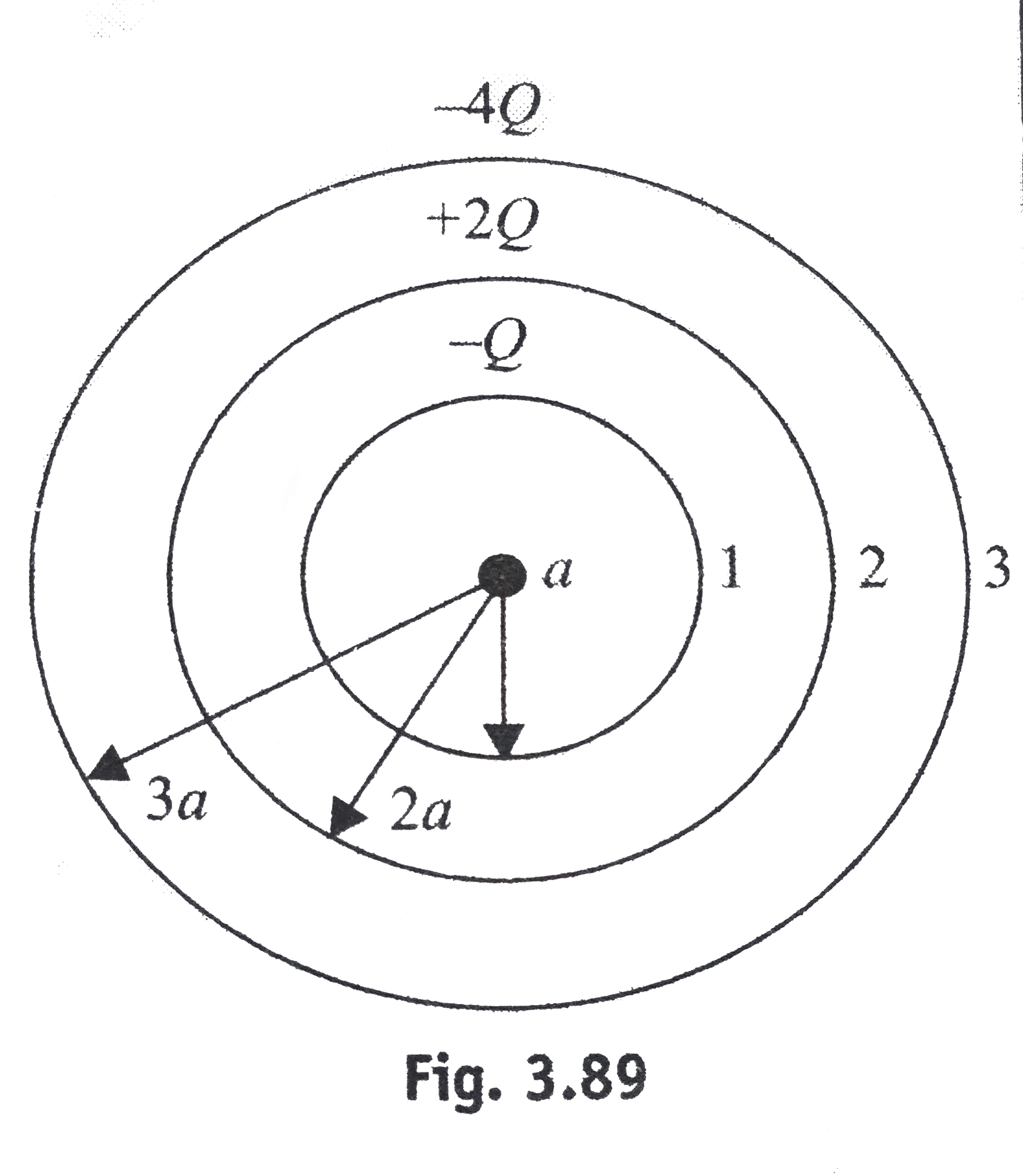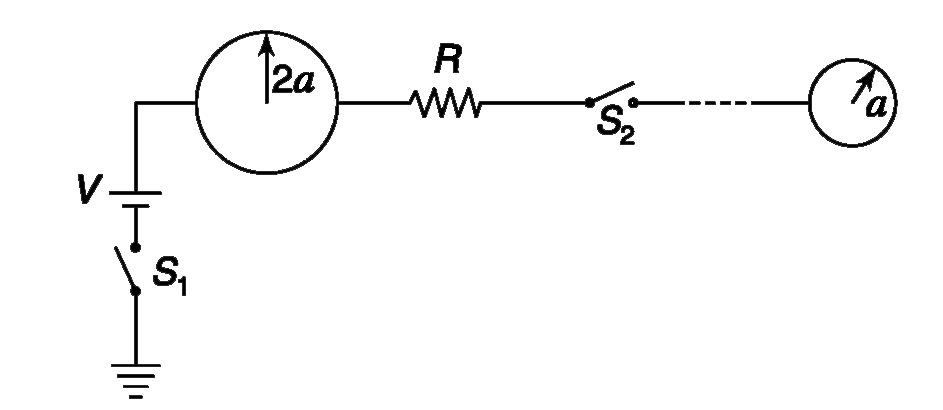Two spherical raindrops of radii 1 mm and 2 mm come in contact with a lighting conductor at a potential of 500 volts and coalesce. Find the potnetial of the resulting drop and the electrical energy they acquired form the dconductor and gained or lost subsquently due to coalescence after getting detached from the conductor.
The correct Answer is:721V,4.172×10−8J,1.8×10−8Jgained due to coalescence.
Step by step video, text & image solution for Two spherical raindrops of radii 1 mm and 2 mm come in contact with a lighting conductor at a potential of 500 volts and coalesce. Find the potnetial of the resulting drop and the electrical energy they acquired form the dconductor and gained or lost subsquently due to coalescence after getting detached from the conductor. by Physics experts to help you in doubts & scoring excellent marks in Class 12 exams.
Topper's Solved these Questions
Similar Questions
Read the following passage and then answer question (a) - (e) on the basis of your understanding of the following passage and the related studied concepts.
As per Bohr atom model, in an isolated atom the energy of any of its electrons depends on the orbit in which it revolves and it is characterised by a sharp energy level. However, inside a crystalline solid atoms are close to each other and the outer orbits of electrons from neighbouring atoms would come very close or could even overlap. As a result, each electron will have a different energy level. These different energy levels with continuous energy variation form energy bands.
The energy band which includes the energy levels of the valence electrons is called the valence band. All the valence electrons reside in the valence band. The energy band above the valence band is called the conduction band. Normally the conduction band is empty.
If the lowest level in the conduction band happens to be lower than the highest level of the valence band, electrons from the valence band may easily move into the conduction band and the solid behaves as a conductor.
If there is some gap between the conduction band and the valence band, electrons in the valence band remain confined to it and no free electrons are available in the conduction band. It makes the solid an insulator.
If some of the electrons from the valence band may gain external energy to cross the gap between the conduction band and valence band, these electrons will move into the conduction band and simultaneously create vacant energy levels in the valence band. Therefore, there is a possibility of conduction due to electrons in conduction band as well as due to vacancies in the valence band.
Name two elements which behave as semiconductors.View SolutionThree concentric spherical conductors of radii a, 2a, and 3a have charges −Q,+2Q, and −4Q, respectively. If r is the distance of the point under consideration from the center of the spheres, then find the electric field and potential due to the given configuration, for the values
(i) r<a
(ii) a<r<2a
(iii) 2a<r<3a
r>3a.
 .View Solution
.View Solution
Knowledge Check
- Question 1 - Select One
Two spherical conductors A and B of radii 1mm and 2mm are separated by a distance of 5 cm and are uniformly charged. If the spheres are connected by a conducting wire, then at equilibrium condition, the ratio of the magnitude of the electric fields at the surface of spheres A and B is
A4:1B1:2C2:1D1:4 - Question 2 - Select One
Two spherical conductors A and B of radii 1mm and 2mm are separated by a distance of 5 cm and are uniformly charged. If the spheres are connected by a conducting wire then in equilibrium condition, the ratio of the magnitude of the electric fields at the surfaces of spheres A and B is
A(a) 4:1B(b) 1:2C(c) 2:1D(d) 2 volt - Question 3 - Select One
A cylindrical copper conductor AB length L areaa of cross-section a has large number of free electrons which at mean temperature move at random within the body of the conductor like the molecules of a gas. The average thermal motion at room temperature is of the enter of 105ms−1 where a potential difference V is applied free electronic in the condictior experience , the free electrons in the conductor experience force and are accelerated towards the positive emf of the condutor on their gained kinetic energy After each collision the free electronic are angle acceleration due of the electric field , towards the positive end the conductor and next collision with the ions/atoms of the electrons The average speed of the free electrons with which they drift toward the positive and of the conductor under the effect of applied electric field is called drift of the electrons
When the potential difference is applied the two ends of the conductors , an electric field existsAoutside the conductorBinside the conductorCboth outside and inside the conductorDno where
In the Fig. two neutral spherical conductors of radii 2aanda are separated by a large distance. Initially, switch S1 is kept closed and S2 is open. Now S1 is opened and S2 is closed at t=0.
(a) Find the rate of fall in potential of the conductor of radius 2a as a function of time.
(b) find the heat dissipated after S2 is closed.
 View Solution
View SolutionA cylindrical copper conductor AB length L areaa of cross-section a has large number of free electrons which at mean temperature move at random within the body of the conductor like the molecules of a gas. The average thermal motion at room temperature is of the enter of 105ms−1 where a potential difference V is applied free electronic in the condictior experience , the free electrons in the conductor experience force and are accelerated towards the positive emf of the condutor on their gained kinetic energy After each collision the free electronic are angle acceleration due of the electric field , towards the positive end the conductor and next collision with the ions/atoms of the electrons The average speed of the free electrons with which they drift toward the positive and of the conductor under the effect of applied electric field is called drift of the electrons
The motion of electrons in between two successive collisions with the atoms/ions followsView SolutionWhen liquid medicine of density ρ is to put in the eye, it is done with the help of a dropper. As the bulp on the top of the dropper is pressed, a drop forms at the opening of the dropper. We wish to estimate the size of the drop. We first assume that the drop formed at the opening is spherical because that requires a minimum increase in its surface energy. To determine the size, we calculate the net vertical force due to the surface tension T when the radius of the drop is R. When this force becomes smaller than the weight of the drop, the drop gets detached from the dropper.
If r=5×10−4m, ρ=103kgm−3, g=10ms−2, T=0.11Nm−1, the radius of the drop when it detaches from the dropper is approximatelyView SolutionWhen liquid medicine of density ρ is to be put in the eye, it is done with the help of a dropper. As the bulb on the top of the dropper is pressed, a drop forms at the opening of the dropper. We wish to estimate the size of te drop. We first assume that the drop formed at the opening is spherical because that requires a minimum increase in its surface energy. To determine the size, we calculate the net vertical force due to the surfacetension T when the radius of the drop is R. When this force becomes smaller than the weight of the drop, the drop gets detached from the dropper.
If r=5×10−4m ˜n=103kgm−3, g=10ms−2, T=0.11Nm−1 the radius of the drop when it detaches from the dropper is approximatelyView SolutionWhen liquid medicine of density ρ is to be put in the eye, it is done with the help of a dropper. As the bylb on the top of the dropper is pressed. A drop frons at the opening of the dropper. We wish to estimate the size of the drop.
We first assume that the drop formed at the opening is spherical because that requires a minimum increase in its surface energy, To determine the size. We calculate the net vertical force due to the surface tension T when the radius of the drop is R. when this force become smaller than the weight of the drop the drop gets detached from the dropper.
If r=5×10−4m,ρ=103kgm−3,g=10ms−2,T=0.11Nm−1, The radius of the drop when it detaches from the dropper is approximately,View Solution

